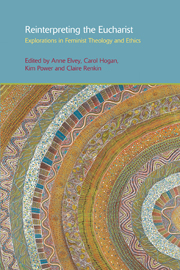Book contents
- Frontmatter
- Contents
- List of Illustrations
- Foreword
- Acknowledgements
- Contributors
- 1 Introduction
- 2 Eucharistic Metamorphosis: Changing Symbol, Changing Lives
- 3 The Sunday Eucharist: Embodying Christ in a Prophetic Act
- 4 How Australian Aboriginal Christian Womanist Tiddas (Sisters) Theologians Celebrate the Eucharist
- 5 Women, Eucharist, and Good News to All Creation in Mark
- 6 Rediscovering Forgotten Features: Scripture, Tradition and Whose Feet May Be Washed on Holy Thursday Night
- 7 Mystery Appropriated: Disembodied Eucharist and Meta-theology
- 8 Real Presence: Seeing, Touching, Tasting: Visualizing the Eucharist in Late Medieval Art
- 9 Embodying the Eucharist
- 10 Living One for the Other: Eucharistic Hospitality as Ecological Hospitality
- Subject Index
- Name Index
Foreword
- Frontmatter
- Contents
- List of Illustrations
- Foreword
- Acknowledgements
- Contributors
- 1 Introduction
- 2 Eucharistic Metamorphosis: Changing Symbol, Changing Lives
- 3 The Sunday Eucharist: Embodying Christ in a Prophetic Act
- 4 How Australian Aboriginal Christian Womanist Tiddas (Sisters) Theologians Celebrate the Eucharist
- 5 Women, Eucharist, and Good News to All Creation in Mark
- 6 Rediscovering Forgotten Features: Scripture, Tradition and Whose Feet May Be Washed on Holy Thursday Night
- 7 Mystery Appropriated: Disembodied Eucharist and Meta-theology
- 8 Real Presence: Seeing, Touching, Tasting: Visualizing the Eucharist in Late Medieval Art
- 9 Embodying the Eucharist
- 10 Living One for the Other: Eucharistic Hospitality as Ecological Hospitality
- Subject Index
- Name Index
Summary
Often when I have been reflecting after Communion, I cannot help but realize how much there is in the Church's liturgy that has been in the Aboriginal culture for aeons of time.
Aboriginal people are very conscious of being part of a group whose lifestyle is immersed in the spiritual. The daily life of Aborigines was centred around the campfire. In the evening they gathered around the fire to share the food that men had hunted and women had collected. Other things were also shared—the experiences of the day, the telling of stories, and sometimes aspects of the law would be discussed. Things both joyful and serious would be brought to this special place around the fire, which was central to living and sacred to the community. At times, these things were enhanced by song and dance.
The community of the Church also gathers around a focal point — the Altar—with candles as symbols of God's presence. They share a meal which is sacred—the Eucharist. The bread and wine has also been gathered by people: the bread coming from the wheat brought in from the fields and cooked in ovens, and the grapes picked from the vines in the vineyards, matured and bottled as wine for God's purposes. They, too, listen to stories from scriptural ancestors of long ago, who were given the law from the same Creator Spirit. Their stories are also given added meaning by music and song.
The symbols used in ceremony and ritual in both cultures are also the same—fire, water, oil and smoke. In Aboriginal culture they are used for special and sacred rituals such as birthing rites, initiations, healing purposes and funerals.
- Type
- Chapter
- Information
- Reinterpreting the EucharistExplorations in Feminist Theology and Ethics, pp. ix - xiiPublisher: Acumen PublishingPrint publication year: 2012



